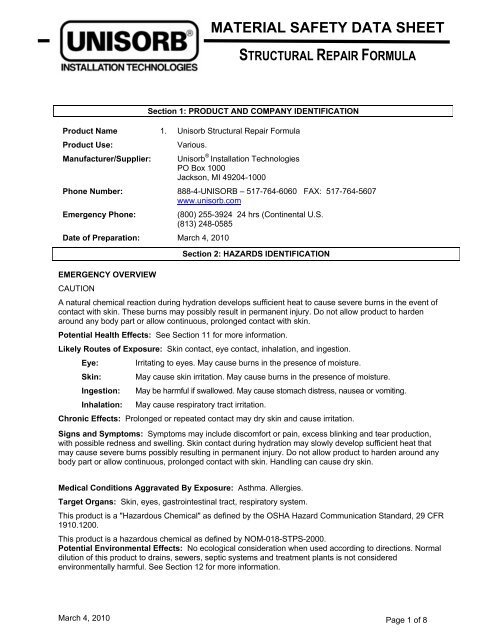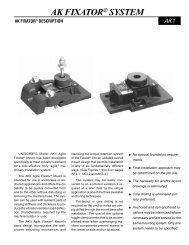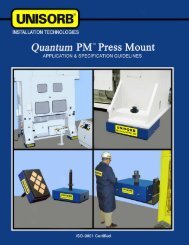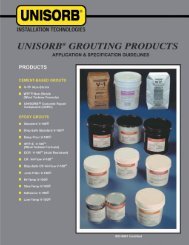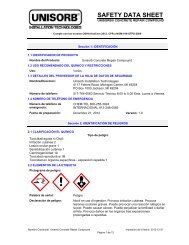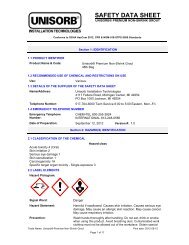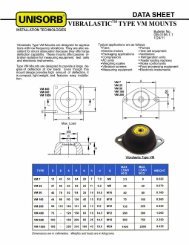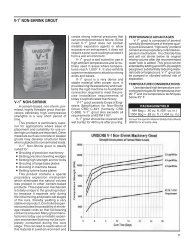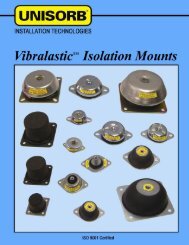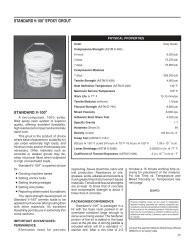MATERIAL SAFETY DATA SHEET - Unisorb Installation Technologies
MATERIAL SAFETY DATA SHEET - Unisorb Installation Technologies
MATERIAL SAFETY DATA SHEET - Unisorb Installation Technologies
You also want an ePaper? Increase the reach of your titles
YUMPU automatically turns print PDFs into web optimized ePapers that Google loves.
<strong>MATERIAL</strong> <strong>SAFETY</strong> <strong>DATA</strong> <strong>SHEET</strong><br />
STRUCTURAL REPAIR FORMULA<br />
Section 1: PRODUCT AND COMPANY IDENTIFICATION<br />
Product Name 1. <strong>Unisorb</strong> Structural Repair Formula<br />
Product Use:<br />
Manufacturer/Supplier:<br />
Various.<br />
<strong>Unisorb</strong> ® <strong>Installation</strong> <strong>Technologies</strong><br />
PO Box 1000<br />
Jackson, MI 49204-1000<br />
Phone Number: 888-4-UNISORB – 517-764-6060 FAX: 517-764-5607<br />
www.unisorb.com<br />
Emergency Phone:<br />
Date of Preparation: March 4, 2010<br />
EMERGENCY OVERVIEW<br />
CAUTION<br />
(800) 255-3924 24 hrs (Continental U.S.<br />
(813) 248-0585<br />
Section 2: HAZARDS IDENTIFICATION<br />
A natural chemical reaction during hydration develops sufficient heat to cause severe burns in the event of<br />
contact with skin. These burns may possibly result in permanent injury. Do not allow product to harden<br />
around any body part or allow continuous, prolonged contact with skin.<br />
Potential Health Effects: See Section 11 for more information.<br />
Likely Routes of Exposure: Skin contact, eye contact, inhalation, and ingestion.<br />
Eye:<br />
Skin:<br />
Ingestion:<br />
Inhalation:<br />
Irritating to eyes. May cause burns in the presence of moisture.<br />
May cause skin irritation. May cause burns in the presence of moisture.<br />
May be harmful if swallowed. May cause stomach distress, nausea or vomiting.<br />
May cause respiratory tract irritation.<br />
Chronic Effects: Prolonged or repeated contact may dry skin and cause irritation.<br />
Signs and Symptoms: Symptoms may include discomfort or pain, excess blinking and tear production,<br />
with possible redness and swelling. Skin contact during hydration may slowly develop sufficient heat that<br />
may cause severe burns possibly resulting in permanent injury. Do not allow product to harden around any<br />
body part or allow continuous, prolonged contact with skin. Handling can cause dry skin.<br />
Medical Conditions Aggravated By Exposure: Asthma. Allergies.<br />
Target Organs: Skin, eyes, gastrointestinal tract, respiratory system.<br />
This product is a "Hazardous Chemical" as defined by the OSHA Hazard Communication Standard, 29 CFR<br />
1910.1200.<br />
This product is a hazardous chemical as defined by NOM-018-STPS-2000.<br />
Potential Environmental Effects: No ecological consideration when used according to directions. Normal<br />
dilution of this product to drains, sewers, septic systems and treatment plants is not considered<br />
environmentally harmful. See Section 12 for more information.<br />
March 4, 2010<br />
Page 1 of 8
<strong>MATERIAL</strong> <strong>SAFETY</strong> <strong>DATA</strong> <strong>SHEET</strong><br />
STRUCTURAL REPAIR FORMULA<br />
Section 3: COMPOSITION / INFORMATION ON INGREDIENTS<br />
Ingredient UN Number H / F/ R / Special* CAS # Wt. %<br />
Portland cement Not available. 2/0/0 65997-15-1 10 - 30<br />
Silica, crystalline, quartz Not available. Not available. 14808-60-7 1 - 5<br />
Calcium aluminate cement Not available. Not available. 65997-16-2 10 - 30<br />
Silica, amorphous, fumed Not available. Not available. 7631-86-9 0.5 - 1.5<br />
Lithium carbonate Not available. Not available. 554-13-2 0.1 - 1<br />
Kaolin Not available. 1/1/0 1332-58-7 1 - 5<br />
* Per NOM-018-STPS-2000<br />
Section 4: FIRST AID MEASURES<br />
Eye Contact:<br />
In case of contact, immediately flush eyes with plenty of water for at least 15 minutes. If<br />
easy to do, remove contact lenses, if worn. Get medical attention immediately.<br />
Skin Contact:<br />
In case of contact, immediately flush skin with plenty of water. Remove contaminated<br />
clothing and shoes. Wash clothing before reuse. Call a physician if irritation develops and<br />
persists.<br />
Inhalation:<br />
Ingestion:<br />
If inhaled, remove to fresh air. If not breathing, give artificial respiration. If breathing is<br />
difficult, give oxygen.<br />
If swallowed, do NOT induce vomiting unless directed to do so by medical personnel.<br />
Never give anything by mouth to an unconscious person.<br />
General Advice: In case of accident or if you feel unwell, seek medical advice immediately<br />
(show the label or MSDS where possible).<br />
Note to Physicians: Symptoms may not appear immediately.<br />
Section 5: FIRE FIGHTING MEASURES<br />
Flammability: Not flammable by WHMIS/OSHA criteria.<br />
Means of Extinguishing:<br />
Suitable Extinguishing Media: Treat for surrounding material.<br />
Unsuitable Extinguishing Media: Not available.<br />
Products of Combustion: May include, and are not limited to: oxides of carbon.<br />
Explosion Data:<br />
Sensitivity to Mechanical Impact: Not available.<br />
Sensitivity to Static Discharge: Not available.<br />
Protection of Firefighters: Keep upwind of fire. Wear full fire fighting turn-out gear (full Bunker<br />
gear) and respiratory protection (SCBA).<br />
March 4, 2010<br />
Page 2 of 8
<strong>MATERIAL</strong> <strong>SAFETY</strong> <strong>DATA</strong> <strong>SHEET</strong><br />
STRUCTURAL REPAIR FORMULA<br />
Section 6: ACCIDENTAL RELEASE MEASURES<br />
Personal Precautions: Use personal protection recommended in Section 8. Isolate the hazard area and<br />
deny entry to unnecessary and unprotected personnel.<br />
Environmental Precautions: If large quantities enter a waterway, advise local authorities.<br />
Methods for Containment: Contain spill, then place in a suitable container. Do not flush to sewer or<br />
allow to enter waterways. Use appropriate Personal Protective Equipment (PPE).<br />
Methods for Clean-Up: Vacuum or sweep material and place in a disposal container.<br />
Other Information: Not available.<br />
Section 7: HANDLING AND STORAGE<br />
Handling:<br />
Avoid contact with skin and eyes. Do not swallow. Good housekeeping is important to prevent accumulation of<br />
dust. Avoid generating and breathing dust. The use of compressed air for cleaning clothing, equipment, etc, is not<br />
recommended. Handle and open container with care. When using do not eat or drink. Wash hands before eating,<br />
drinking, or smoking.<br />
Storage:<br />
Keep out of the reach of children. Store in dust-tight, dry, labeled containers. Keep containers closed when<br />
not in use. Avoid any dust buildup by frequent cleaning and suitable construction of the storage area. Do not<br />
store in an area equipped with emergency water sprinklers. Use corrosion-resistant structural materials and<br />
lighting and ventilation systems in the storage area.<br />
Section 8: EXPOSURE CONTROLS / PERSONAL PROTECTION<br />
Exposure Guidelines<br />
Exposure Limits<br />
Ingredient OSHA-PEL ACGIH-TLV<br />
Portland cement 15 mg/m³ (total); 5 mg/m³ (resp) 10 mg/m³ (total)<br />
Silica, crystalline, quartz<br />
((10 mg/m3)/(%SiO2+2) TWA (resp));<br />
((30 mg/m3)/(%SiO2+2) TWA (total));<br />
((250)/(%SiO2+5) mppcf TWA (resp)) 0.025 mg/m³<br />
Calcium aluminate cement Not available. Not available.<br />
Silica, amorphous, fumed 80 mg/m3/%SiO2 10 mg/m³<br />
Lithium carbonate Not available. Not available.<br />
Kaolin 15 mg/m3 2 mg/m 3<br />
Engineering Controls: When using product, provide local and general exhaust ventilation to<br />
keep airborne dust concentrations below exposure limits.<br />
Personal Protective Equipment:<br />
Eye/Face Protection: Wear approved eye protection (properly fitted dust- or splash-proof<br />
chemical safety goggles) and face protection (face shield).<br />
Hand Protection: Wear suitable gloves.<br />
Skin and Body Protection: Wear suitable protective clothing.<br />
Respiratory Protection: A NIOSH approved dust mask or filtering facepiece is recommended in<br />
poorly ventilated areas or when permissible exposure limits may be exceeded. Respirators should<br />
be selected by and used under the direction of a trained health and safety professional following<br />
requirements found in OSHA’s respirator standard (29 CFR 1910.134) and ANSI’s standard for<br />
respiratory protection (Z88.2).<br />
General Hygiene Considerations: Handle according to established industrial hygiene and safety<br />
practices.<br />
March 4, 2010<br />
Page 3 of 8
<strong>MATERIAL</strong> <strong>SAFETY</strong> <strong>DATA</strong> <strong>SHEET</strong><br />
STRUCTURAL REPAIR FORMULA<br />
Section 9: PHYSICAL AND CHEMICAL PROPERTIES<br />
Appearance:<br />
Color:<br />
Odor:<br />
Odor Threshold:<br />
Physical State:<br />
pH:<br />
Viscosity:<br />
Freezing Point:<br />
Boiling Point:<br />
Flash Point:<br />
Evaporation Rate:<br />
Lower Flammability Limit:<br />
Upper Flammability Limit:<br />
Vapor Pressure:<br />
Vapor Density:<br />
Specific Gravity:<br />
Solubility in Water:<br />
Coefficient of Water/Oil Distribution:<br />
Auto-ignition Temperature:<br />
Percent Volatile, wt. %:<br />
VOC content, wt. %:<br />
Powder.<br />
Various.<br />
Characteristic.<br />
Not available.<br />
Powder.<br />
Not available.<br />
Not available.<br />
Not available.<br />
Not available.<br />
Not available.<br />
Not available.<br />
Not available.<br />
Not available.<br />
Not available.<br />
Not available.<br />
Not available.<br />
Not available.<br />
Not available.<br />
Not available.<br />
Not available.<br />
0%, Not applicable; 0 wt, Not applicable.<br />
Section 10: STABILITY AND REACTIVITY<br />
Stability: Stable under normal storage conditions. Keep dry in storage.<br />
Conditions of Reactivity: Heat. Incompatible materials. Moisture.<br />
Incompatible Materials: None known.<br />
Hazardous Decomposition Products: May include, and are not limited to: oxides of carbon.<br />
Possibility of Hazardous Reactions: No dangerous reaction known under conditions of normal use.<br />
March 4, 2010<br />
Page 4 of 8
<strong>MATERIAL</strong> <strong>SAFETY</strong> <strong>DATA</strong> <strong>SHEET</strong><br />
STRUCTURAL REPAIR FORMULA<br />
EFFECTS OF ACUTE EXPOSURE<br />
Component Analysis<br />
Section 11: TOXICOLOGY INFORMATION<br />
Ingredient IDLH LD 50 (oral) LC 50<br />
Portland cement Not available. Not available. Not available.<br />
Silica, crystalline, quartz Not available 500 mg/kg, rat Not available.<br />
Calcium aluminate cement Not available. Not available. Not available.<br />
Silica, amorphous, fumed 3000 mg/m3 Not available. Not available.<br />
Lithium carbonate Not available 525 mg/kg, rat Not available.<br />
Kaolin Not available. Not available. Not available.<br />
Eye:<br />
Skin:<br />
Ingestion:<br />
Inhalation:<br />
Irritating to eyes. May cause burns in the presence of moisture. Symptoms may include<br />
discomfort or pain, excess blinking and tear production, with possible redness and swelling.<br />
May cause skin irritation. May cause burns in the presence of moisture. Skin contact during<br />
hydration may slowly develop sufficient heat that may cause severe burns possibly resulting<br />
in permanent injury. Do not allow product to harden around any body part or allow<br />
continuous, prolonged contact with skin. Handling can cause dry skin.<br />
May be harmful if swallowed. May cause stomach distress, nausea or vomiting.<br />
May cause respiratory tract irritation.<br />
EFFECTS OF CHRONIC EXPOSURE<br />
Target Organs: Lungs.<br />
Chronic Effects: Hazardous by WHMIS/OSHA criteria.<br />
Respirable crystalline silica in the form of quartz or cristobalite from occupational sources is listed by the<br />
International Agency for Research on Cancer (IARC) and National Toxicology Program (NTP) as a lung<br />
carcinogen. Prolonged exposure to respirable crystalline silica has been known to cause silicosis, a lung<br />
disease, which may be disabling. While there may be a factor of individual susceptibility to a given<br />
exposure to respirable silica dust, the risk of contracting silicosis and the severity of the disease is clearly<br />
related to the amount of dust exposure and the length of time (usually years) of exposure.<br />
Carcinogenicity: Hazardous by WHMIS/OSHA criteria.<br />
Ingredient<br />
Portland cement<br />
Silica, crystalline, quartz<br />
Calcium aluminate cement<br />
Silica, amorphous, fumed<br />
Lithium carbonate<br />
Kaolin<br />
* See Section 15 for more information.<br />
Mutagenicity: Not hazardous by WHMIS/OSHA criteria.<br />
Reproductive Effects: Not hazardous by WHMIS/OSHA criteria.<br />
Developmental Effects:<br />
Teratogenicity: Not hazardous by WHMIS/OSHA criteria.<br />
Embryotoxicity: Not hazardous by WHMIS/OSHA criteria.<br />
Respiratory Sensitization: Not hazardous by WHMIS/OSHA criteria.<br />
Skin Sensitization: Not hazardous by WHMIS/OSHA criteria.<br />
Toxicologically Synergistic Materials: Not available.<br />
Chemical Listed as Carcinogen or<br />
Potential Carcinogen *<br />
Not listed.<br />
G-A2, I-1, N-1, CP65<br />
Not listed.<br />
I-3, N-1, CP65<br />
CP65<br />
Not listed.<br />
March 4, 2010<br />
Page 5 of 8
<strong>MATERIAL</strong> <strong>SAFETY</strong> <strong>DATA</strong> <strong>SHEET</strong><br />
STRUCTURAL REPAIR FORMULA<br />
Section 12: ECOLOGICAL INFORMATION<br />
Ecotoxicity: No ecological consideration when used according to directions. Normal dilution of this<br />
product to drains, sewers, septic systems and treatment plants is not considered environmentally harmful.<br />
Persistence / Degradability: Not available.<br />
Bioaccumulation / Accumulation: Not available.<br />
Mobility in Environment: Not available.<br />
Section 13: DISPOSAL CONSIDERATIONS<br />
Disposal Instructions:<br />
This material must be disposed of in accordance with all local, state, provincial, and federal regulations.<br />
DOT Classification<br />
Not regulated<br />
TDG Classification<br />
Not regulated<br />
NOM-004-SCT2-1994 Classification<br />
Not regulated<br />
Federal Regulations<br />
Section 14: TRANSPORTATION INFORMATION<br />
Section 15: REGULATORY INFORMATION<br />
Canadian: This product has been classified in accordance with the hazard criteria of the Controlled<br />
Products Regulations and the MSDS contains all the information required by the Controlled Products<br />
Regulations.<br />
US: MSDS prepared pursuant to the Hazard Communication Standard (CFR29 1910.1200).<br />
Mexico: MSDS prepared pursuant to NOM-018-STPS-2000.<br />
SARA Title III<br />
Ingredient Section 302<br />
(EHS) TPQ<br />
(lbs.)<br />
Section 304<br />
EHS RQ<br />
(lbs.)<br />
CERCLA<br />
RQ (lbs.)<br />
Section<br />
313<br />
Portland cement Not listed. Not listed. Not listed. Not listed.<br />
Silica, crystalline, quartz Not listed. Not listed. Not listed. Not listed.<br />
Calcium aluminate cement Not listed. Not listed. Not listed. Not listed.<br />
Silica, amorphous, fumed Not listed. Not listed. Not listed. Not listed.<br />
Lithium carbonate Not listed. Not listed. Not listed. 313<br />
Kaolin Not listed. Not listed. Not listed. Not listed.<br />
State Regulations<br />
California Proposition 65:<br />
This product contains a chemical known to the state of California to cause cancer.<br />
Global Inventories<br />
Ingredient<br />
Canada<br />
DSL/NDSL<br />
USA<br />
TSCA<br />
Portland cement DSL Yes.<br />
Silica, crystalline, quartz DSL Yes.<br />
Calcium aluminate cement DSL Yes.<br />
Silica, amorphous, fumed DSL Yes.<br />
Lithium carbonate DSL Yes.<br />
Kaolin DSL Yes.<br />
March 4, 2010<br />
Page 6 of 8
<strong>MATERIAL</strong> <strong>SAFETY</strong> <strong>DATA</strong> <strong>SHEET</strong><br />
STRUCTURAL REPAIR FORMULA<br />
HMIS - Hazardous Materials Identification System<br />
Health - 2* Flammability - 0 Physical Hazard - 0<br />
NFPA - National Fire Protection Association:<br />
Health - 2 Fire - 0 Reactivity - 0<br />
Hazard Rating: 0 = minimal, 1 = slight, 2 = moderate, 3 = severe, 4 = extreme<br />
WHMIS Classification(s):<br />
Class D2A - Carcinogenicity<br />
Class D2A - Chronic Toxic Effects<br />
Class D2B - Skin/Eye Irritant<br />
WHMIS Hazard Symbols:<br />
Mexico Classification:<br />
Blue = Health Red = Flammability Yellow = Reactivity White = Special<br />
Hazard Rating: 0 = minimal, 1 = slight, 2 = moderate, 3 = severe, 4 = extreme<br />
SOURCE AGENCY CARCINOGEN CLASSIFICATIONS:<br />
OSHA (O)<br />
ACGIH (G)<br />
IARC (I)<br />
NTP (N)<br />
Occupational Safety and Health Administration.<br />
American Conference of Governmental Industrial Hygienists.<br />
A1 - Confirmed human carcinogen.<br />
A2 - Suspected human carcinogen.<br />
A3 - Animal carcinogen.<br />
A4 - Not classifiable as a human carcinogen.<br />
A5 - Not suspected as a human carcinogen.<br />
International Agency for Research on Cancer.<br />
1 - The agent (mixture) is carcinogenic to humans.<br />
2A - The agent (mixture) is probably carcinogenic to humans; there is limited evidence of carcinogenicity in<br />
humans and sufficient evidence of carcinogenicity in experimental animals.<br />
2B - The agent (mixture) is possibly carcinogenic to humans; there is limited evidence of carcinogenicity in<br />
humans in the absence of sufficient evidence of carcinogenicity in experimental animals.<br />
3 - The agent (mixture, exposure circumstance) is not classifiable as to its carcinogenicity to humans.<br />
4 - The agent (mixture, exposure circumstance) is probably not carcinogenic to humans.<br />
National Toxicology Program.<br />
1 - Known to be carcinogens.<br />
2 - Reasonably anticipated to be carcinogens.<br />
March 4, 2010<br />
Page 7 of 8
<strong>MATERIAL</strong> <strong>SAFETY</strong> <strong>DATA</strong> <strong>SHEET</strong><br />
STRUCTURAL REPAIR FORMULA<br />
Section 16: OTHER INFORMATION<br />
Disclaimer:<br />
The information contained in this document applies to this specific material as supplied. It may<br />
not be valid for this material if it is used in combination with any other materials. It is the user’s<br />
responsibility to satisfy oneself as to the suitability and completeness of this information for the<br />
user’s own particular use.<br />
Expiry Date: March 4, 2013<br />
Version #: 1.0<br />
Prepared by:<br />
Nexreg Compliance Inc.<br />
Phone: (519) 488-5126<br />
www.nexreg.com<br />
March 4, 2010<br />
Page 8 of 8


